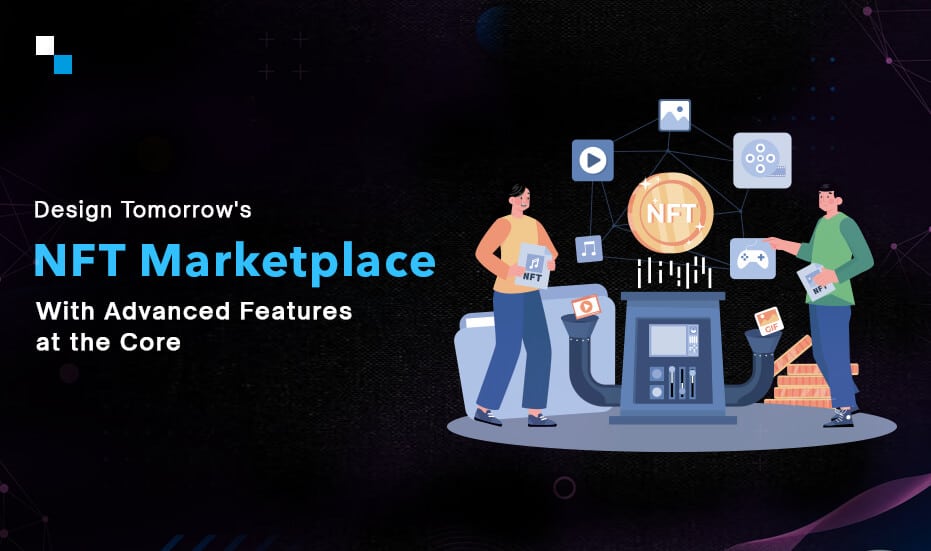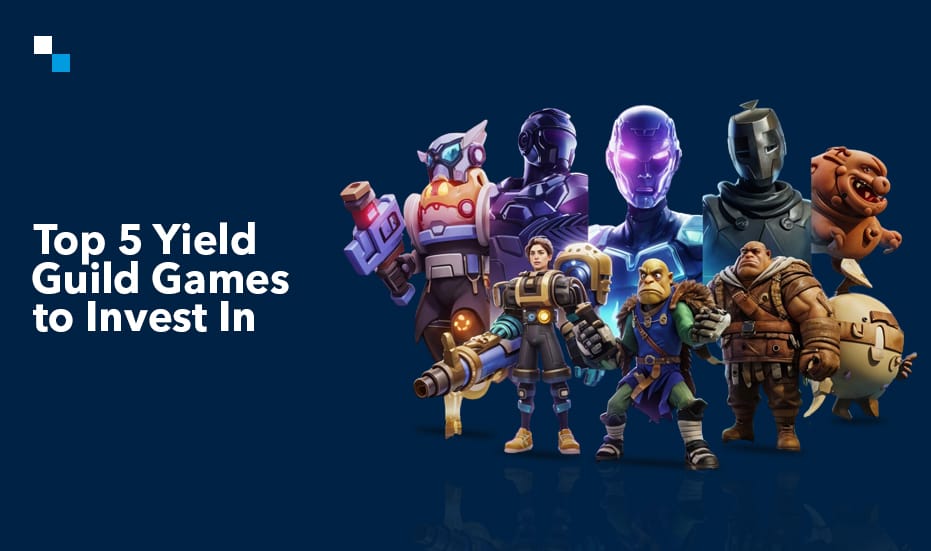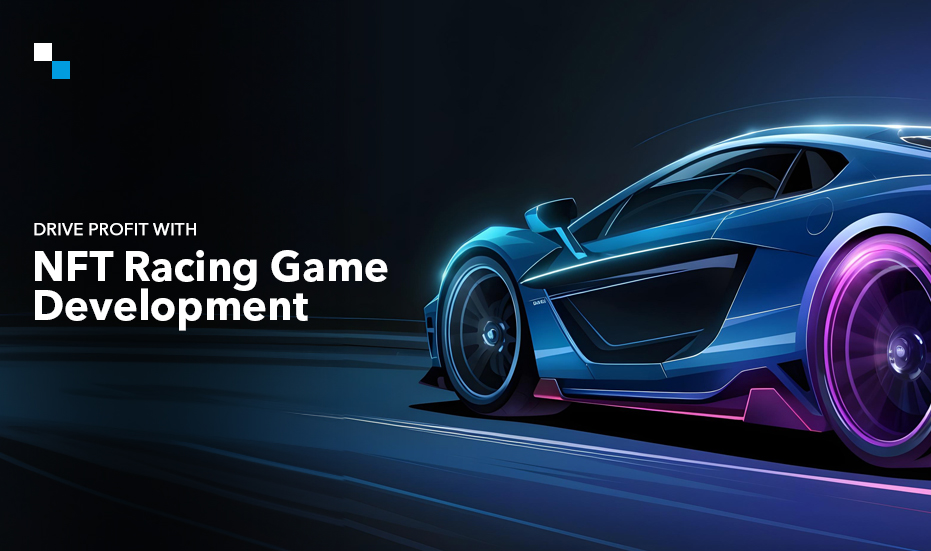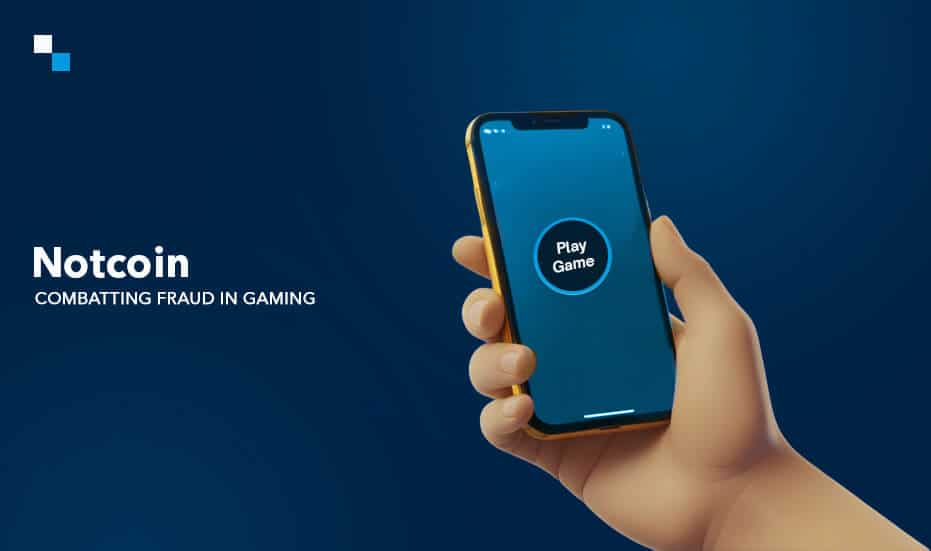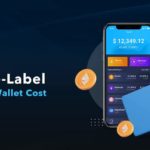
Navigating the Cost of Building a White Label Crypto Wallet
August 21, 2023
Navigating DeFi Safely: 9 Ways to Protecting Your Private Keys and Securing Your Financial Future
August 22, 2023In the ever-evolving landscape of blockchain technology and digital assets, Non-Fungible Tokens (NFTs) have taken center stage. NFT marketplaces have become bustling hubs where artists, collectors, and enthusiasts converge to buy, sell, and trade unique digital creations. As this ecosystem continues to flourish, the integration of advanced features while conducting NFT marketplace development serves as a catalyst for innovation and enhanced user experiences.
The Evolution of NFT Marketplaces By Integrating Advanced Features
NFT marketplaces have come a long way since their inception. Earlier, they were merely considered digital platforms that facilitated artists to tokenize and sell their digital art. Now, they have evolved into dynamic ecosystems encompassing various forms of creativity, from music and virtual real estate to virtual pets and beyond. According to Statista, NFT marketplace revenue is anticipated to expand at a rate of 18.55% per year (CAGR 2023–2027), translating to a projected total of US$3,162m by 2027. This rapid expansion has paved the way for the integration of advanced features that are reshaping the NFT landscape. Thus, if you are about to start a new platform, you must discuss the trending features with the NFT marketplace development company before inviting a quote.
Here are some of the noteworthy features that must be included in next-gen NFT marketplaces:
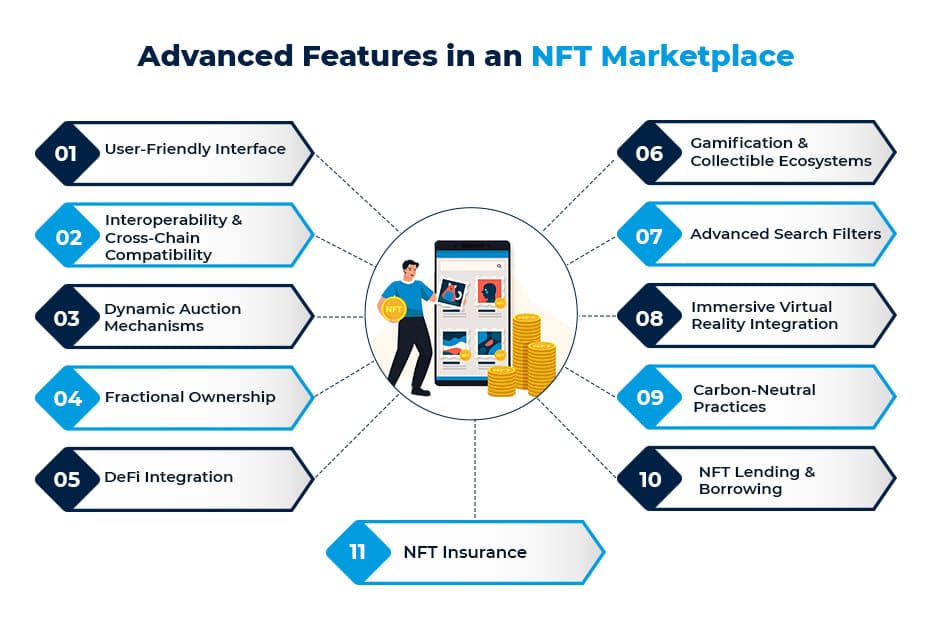
1. User-Friendly Interface
The journey begins with the user. Today, NFT marketplace development services ensure that they are offering seamless onboarding experiences that guide users through the complexities of blockchain technology. User-friendly interfaces facilitate the broader adoption of NFTs and expand the community.
The user interface should be easy to understand and navigate. The menus and buttons should be clear and easy to find, and the overall layout should be logical and easy to follow.
The marketplace should have a powerful search function that allows users to easily find the NFTs they are looking for. The search function should be able to filter results by a variety of criteria, such as category, price, and artist.
2. Interoperability & Cross-Chain Compatibility
In a multi-blockchain world, interoperability is key. Advanced NFT marketplaces are designed to support multiple blockchains, enabling users to seamlessly interact with NFTs regardless of the underlying technology. This cross-chain compatibility enhances liquidity, accessibility, and overall market dynamics.
Interoperability and cross-chain compatibility can help to expand the reach of NFT marketplaces by making it easier for users to buy and sell NFTs on different blockchains. This is because it allows users to access a wider pool of buyers and sellers, which can lead to increased trading volume.
This feature enhances security by making it more difficult for hackers to steal NFTs. This is because it requires hackers to compromise multiple blockchains in order to steal an NFT.
It also helps to reduce gas fees by allowing NFTs to be traded on the blockchain with the lowest fees. This is because it allows users to avoid paying high gas fees on blockchains with congested networks.
3. Dynamic Auction Mechanisms
When doing NFT marketplace development, it will be necessary to keep innovative auction mechanisms in mind. They can be more efficient than traditional auction mechanisms, as they can adjust the price of an NFT based on real-time demand. They can help to prevent price manipulation, as the price of an NFT is not determined by a single bidder.
Some of the most popular auction mechanisms include:
- English auction
- Dutch auction
- Reverse auction
- Fixed-price auction
- Vickrey auction
4. Fractional Ownership
Fractional ownership democratizes NFT ownership by allowing users to invest in high-value assets collaboratively. Fractional ownership makes it possible for more people to own NFTs, even if they cannot afford to purchase the entire NFT. This can help to democratize the NFT market and make it more accessible to a wider range of people.
It helps to increase the liquidity of NFTs, making it easier for people to buy and sell them. This can be beneficial for both buyers and sellers, as it can make it easier to find a buyer or seller for an NFT at a fair price. Apart from this, Fractional ownership can help to mitigate the risk of dilution, which is the risk that the value of an NFT will decrease due to the issuance of more NFTs of the same type. This is because fractional ownership allows people to own a smaller fraction of an NFT, which means that they are less exposed to the risk of dilution.
5. DeFi Integration
A seasoned NFT marketplace development company can seamlessly integrate decentralized finance (DeFi) protocols, enabling users to trade fractions of NFTs, unlocking liquidity and diversification opportunities.
At the same time, when NFT marketplace development services opt for DeFi integration, it allows people to use their NFTs as collateral for loans, which can provide them with access to liquidity without having to sell their NFTs. This can be beneficial for people who need to raise money quickly but do not want to sell their NFTs. It also allows people to stake their NFTs to earn rewards, such as tokens or interest. This can be a way for people to earn passive income from their NFTs.
6. Gamification & Collectible Ecosystems
Gamification enhances user engagement by introducing elements of competition, achievement, and reward. Some advanced NFT marketplace development specialists incorporate gamified features, turning NFT ownership into an interactive experience. Collectible ecosystems, complete with achievements, badges, and leaderboard rankings, incentivize active participation and nurture a sense of community.
Gamification can help to increase engagement in NFT marketplaces by making it more fun and rewarding to interact with the platform. This can be done by incorporating game-like elements, such as challenges, rewards, and leaderboards.
Collectible ecosystems can help to improve liquidity in NFT marketplaces by creating a more vibrant and active trading community. This can be done by providing users with a place to showcase their collections, as well as by facilitating the trading of NFTs.
NFT marketplace development services can build gamification and collectible ecosystems that increase the capability of NFT marketplaces to attract new users and make them more accessible and appealing. This can be done by creating a more welcoming and inviting environment for users, as well as by offering a variety of features and functionality that appeal to a wide range of interests.

7. Advanced Search Filters
As NFT marketplaces grow, discoverability becomes paramount. Advanced platforms leverage sophisticated recommendation algorithms and AI-driven curation to help users explore relevant and intriguing NFTs. Personalized discovery feeds and tailored recommendations create a more immersive and serendipitous browsing experience.
Advanced search filters can help users to find the NFTs that they are looking for more easily and quickly. This can improve the user experience of the NFT marketplace and make it more likely that users will return to the platform.
Advanced search filters can help to increase the liquidity of the NFT marketplace by making it easier for buyers and sellers to find each other. This can lead to more NFTs being traded and higher prices being achieved.
Advanced search filters during NFT marketplace development can help to improve the efficiency of the NFT platform by making it easier for buyers and sellers to find each other and agree on a price. This can lead to fairer prices being achieved and a more efficient market overall.
8. Immersive Virtual Reality Integration
Pushing boundaries even further, some advanced NFT marketplaces are integrating with virtual reality (VR) environments. Users can explore, showcase, and interact with their NFT collections in immersive VR worlds, bridging the gap between the physical and digital realms.
VR can provide users with an enhanced and immersive experience when interacting with NFTs. This can be done by allowing users to view NFTs in 3D and explore them in a virtual environment. This can help users to better understand and appreciate the value of NFTs.
VR can help to increase engagement with NFTs by making them more interactive and engaging. This can be done by allowing users to interact with NFTs in a variety of ways, such as by rotating them, zooming in and out, and even placing them in their own virtual environment.
VR can open up new business opportunities for NFT marketplaces. For example, VR can be used to create virtual worlds where users can interact with NFTs and each other. This can lead to new ways of selling, buying, and trading NFTs.
9. Carbon-Neutral Practices
Modern NFT marketplaces acknowledge the environmental concerns associated with blockchain technology. An NFT marketplace development company can take carbon-neutral initiatives, make eco-friendly blockchain choices, and contribute to environmental causes demonstrating a commitment to mitigating the carbon footprint of NFT transactions.
NFT marketplaces can offset their emissions by investing in projects that reduce or remove greenhouse gases from the atmosphere. This could include projects such as planting trees, investing in renewable energy, or capturing and storing carbon dioxide. NFT marketplaces can use renewable energy to power their operations. This could include using solar power, wind power, or hydroelectric power.
NFT marketplace development services can implement efficiency measures to reduce the amount of energy used by the platform they are about to create. This could include using energy-efficient hardware, optimizing their software, and reducing the number of transactions that are processed.
10. NFT Lending & Borrowing
NFT lending and borrowing have emerged as an advanced facet within NFT marketplaces, enabling users to leverage their valuable digital assets as collateral for loans. This innovative feature facilitates liquidity, allowing collectors to access funds while retaining ownership. Borrowers benefit from temporary access to NFTs of interest. Such dynamic interactions expand the utility of NFTs and foster a more versatile ecosystem.
NFT lending and borrowing can give NFT holders access to capital without having to sell their NFTs. This can be useful for NFT holders who need money for short-term expenses or who want to invest in other NFTs.
NFT lending and borrowing can help NFT holders to diversify their portfolios. This is because it allows them to use their NFTs as collateral to borrow money, which can then be used to purchase other assets, such as stocks or bonds. This can help to reduce the risk of their portfolio if the value of their NFTs decreases.
11. NFT Insurance
NFT insurance emerges as a pioneering advanced feature within NFT marketplaces, providing collectors and creators with a safety net against potential loss or damage of their valuable digital assets. NFT insurance can also cover loss or damage to NFTs. This is important because NFTs are digital assets, which means that they can be lost or damaged in a variety of ways.
NFT insurance can protect users against fraud and theft. This is important because NFTs are stored on the blockchain, which is a public ledger. This means that anyone can access the blockchain and see the ownership history of an NFT. This makes it possible for scammers to steal NFTs or sell fake NFTs. Doing NFT marketplace development by adding an insurance feature can help to mitigate these risks by providing financial compensation to users who lose their NFTs to fraud or theft.
NFT insurance can increase liquidity in the NFT market. This is because it can make users more confident in buying and selling NFTs. If users know that their NFTs are protected by insurance, they are more likely to be willing to sell them. This can lead to an increase in the number of NFTs being traded, which can make the market more liquid.
Fortifying NFT Marketplace Security
NFT marketplace development services are deploying a range of advanced security measures to ensure a safe and secure environment for creators, collectors, and investors.
- Smart Contract Audits and Penetration Testing
One of the primary security considerations in NFT marketplace development is the audit of smart contracts. Expert blockchain auditors meticulously review the code for vulnerabilities, ensuring that the contracts are free from potential exploits. Rigorous penetration testing further evaluates the system’s resilience against cyberattacks, enabling vulnerabilities to be identified and rectified before deployment.
- Multi-Layer Authentication and Identity Verification
NFT marketplaces implement multi-layer authentication protocols to prevent unauthorized access to user accounts. Two-factor authentication (2FA), biometric verification, and email confirmation are among the techniques employed. Additionally, identity verification processes ensure that users are who they claim to be, reducing the risk of fraudulent activities
- Secure Wallet Integration
Integrating secure wallets is a fundamental aspect of NFT marketplace security. Cold wallets, hardware wallets, and multi-signature wallets are commonly used to safeguard users’ private keys and digital assets. This ensures that funds are stored offline and are less susceptible to hacking attempts.
- Encryption and Data Protection
Encryption techniques are deployed to protect user information & transaction details and to shield sensitive data from potential breaches. Secure Socket Layer (SSL) encryption guarantees that data transmitted between users and the platform remains confidential and immune to eavesdropping.
- Continuous Monitoring and Incident Response
NFT marketplace development services implement real-time monitoring systems to detect any irregular activities or potential security breaches. Rapid response protocols are established to mitigate the impact of security incidents and ensure a swift resolution, thereby minimizing any potential harm.
Final Thoughts
In the fast-paced world of NFT marketplace development, the integration of advanced features and security measures helps to earn the trust of users. As these marketplaces evolve into sophisticated ecosystems, users can now engage in seamless transactions, explore immersive experiences, and safeguard their digital assets like never before.
Antier specializes in using cutting-edge technology to add robust security protocols to build NFT marketplaces in which creators and collectors can thrive with confidence. It’s an NFT marketplace development company you can rely upon. Share your ideas with us, and let us turn them into reality!
